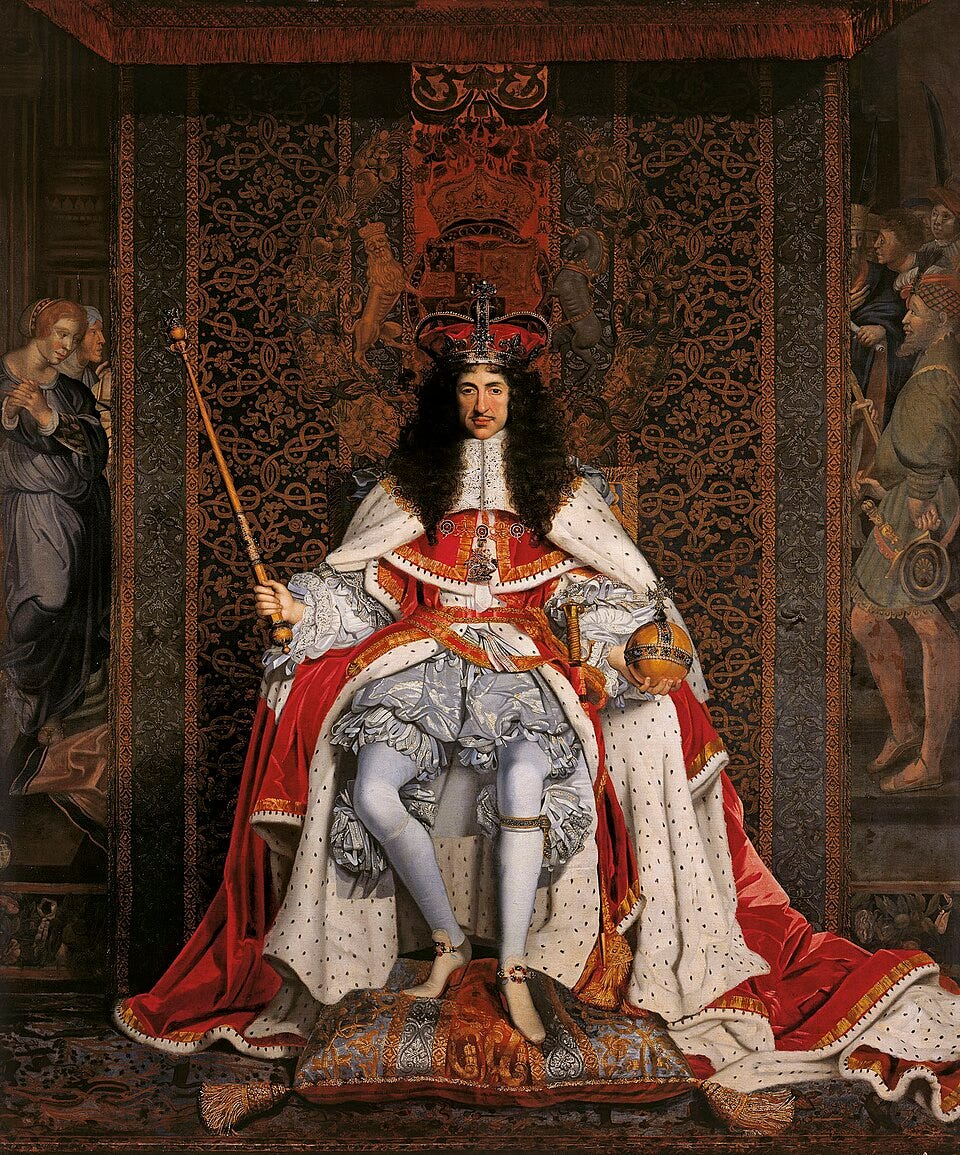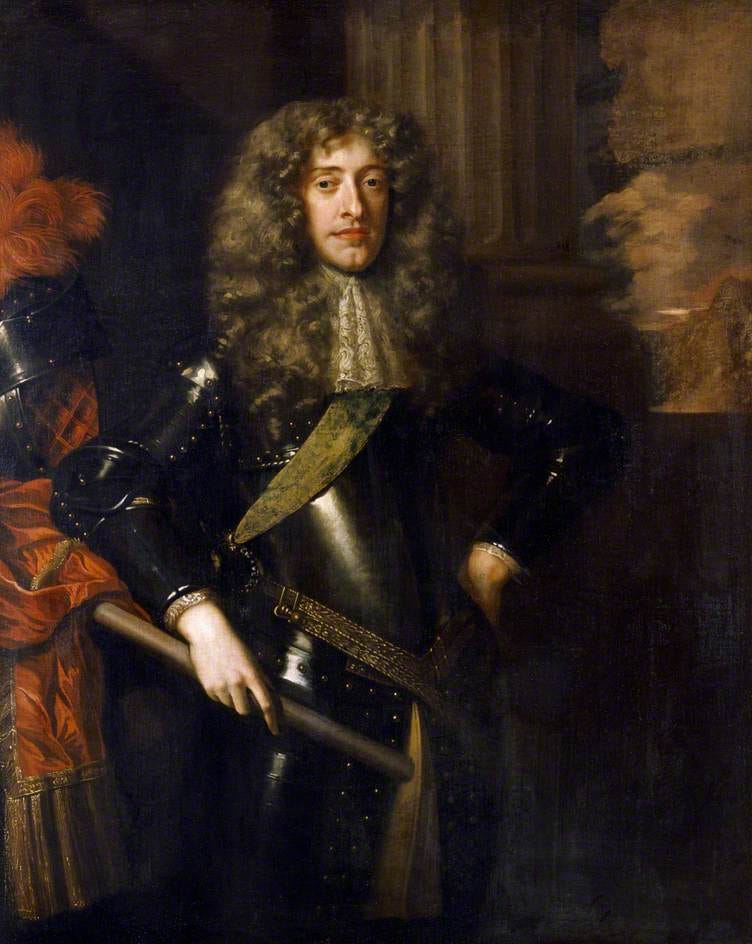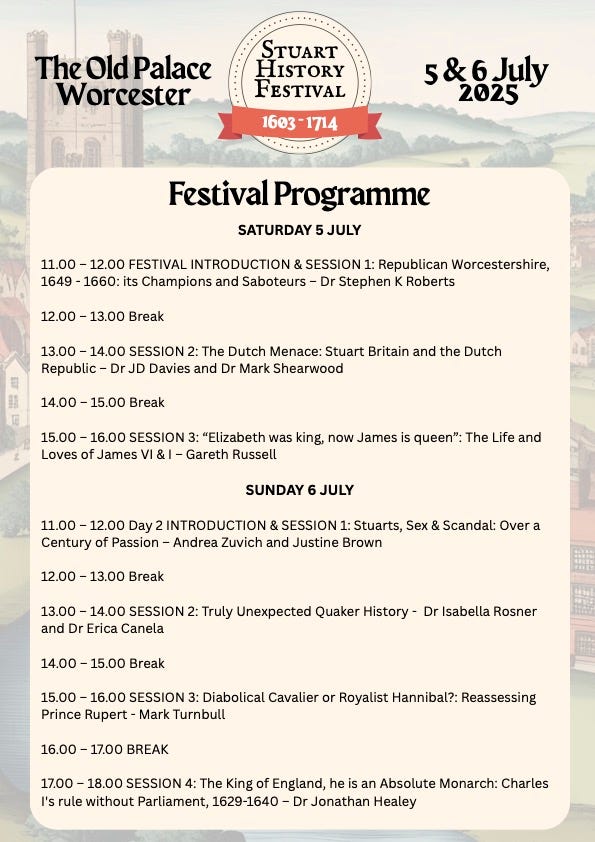Hello fellow history lover!
In the run up to the brand-new ‘Stuart History Festival,’ taking place on the 5th and 6th July, speakers Andrea Zuvich and Justine Brown answer my questions about sex and scandal at the courts of Charles II and James II.
Andrea Zuvich is a British-American cultural anthropologist and historian specialising in the House of Stuart, 1603-1714. She is the author of 'Ravenous: A Life of Charles II's Most Infamous Mistress’ and 'Sex and Sexuality in Stuart Britain', among others. As 'The Seventeenth Century Lady', she hosts the successful live-streamed online history show, 'Stuart Saturday Live'. Zuvich has been interviewed on BBC radio and appeared in history documentaries, including 'Charles I: Downfall of a King'. Zuvich was one of the original developers of the Garden History Tours at Kensington Palace.
Justine Brown was born in Vancouver, Canada, and holds an M.A. in English literature from the University of Toronto, where she developed a broad interest in seventeenth-century culture. There, she became a Junior Fellow of Massey College. The author of ‘The Private Life of James II’ and the forthcoming ‘Mary of Modena: James II’s Dazzling Queen’, she also runs a popular YouTube history vlog, Justine Brown’s Bookshelf.
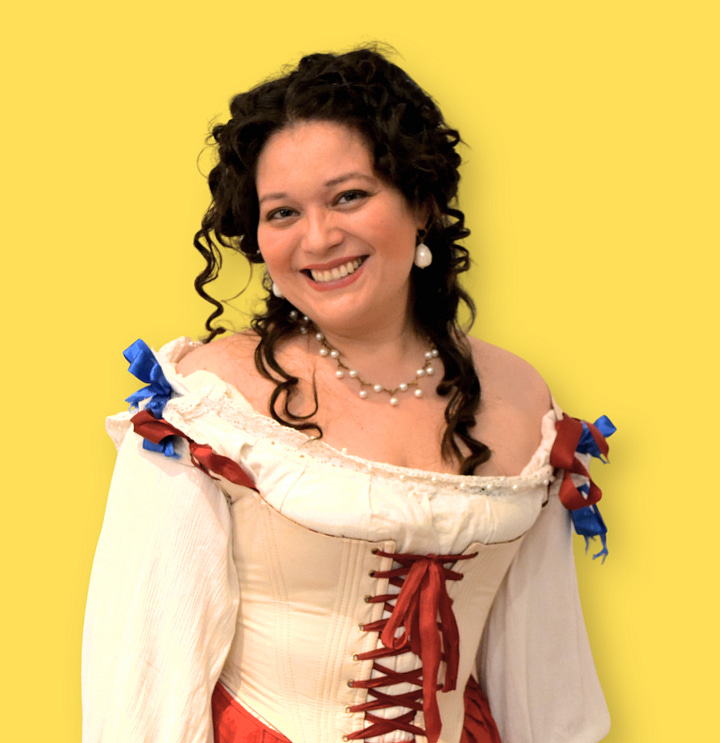

Does Charles II deserve his reputation as a party king?
Andrea: To a certain extent, yes, it is a well-founded reputation. After all, he is often referred to as the ‘Merry Monarch’! During what we call the Restoration in 1660, when the Stuart monarchy was reinstated in all of Britain, the cultural zeitgeist moved away from the decade of radical Puritan ideologies and embraced the opposite. Many things that had previously been frowned upon or downright prohibited during the Interregnum were not only permitted, but encouraged. Playhouses, for example, were reopened, and women were finally allowed to tread the boards, becoming the first actresses. Charles II himself was often a down-to-earth, charismatic fellow who was able to get on very well with people, no matter their station in life.
Charles II’s very active sexual drive was a big part of his life, and his choice of bedfellow often impacted the political sphere of his reign.
According to ‘A Satyr on Charles II’ by John Wilmot, 2nd Earl of Rochester, ‘His sceptre and his prick are of a length, and she may sway the one who plays with the other’.
In late August 1661, Samuel Pepys, a man more famous to us because of his incredible Diary which covered about a decade (1660s), wrote: ‘At Court things are in very ill condition, there being so much emulacion, poverty, and the vices of drinking, swearing, and loose amours, that I know not what will be the end of it, but confusion’. Pepys’s friend, the courtier John Evelyn, wrote similarly in his own diary on 8th January, 1667-68, that: ‘I saw deep and prodigious gaming at the Groom-Porter's, vast heaps of gold squandered away in a vain and profuse manner. This I looked on as a horrid vice, and unsuitable in a Christian Court’. So, we can gather that, even then, Charles II’s contemporaries could plainly see a court that was debauched, that sought pleasure above all other things.
All this said, however, there is a side to Charles II that is often overlooked: he had a very keen interest in natural philosophy (an area that grew into what we’d call science today) and was a founder of the Royal Society, he was seriously interested in the Navy (and I recommend Stuart History Festival speaker, Dr J.D. Davies’ book, Kings of the Sea, which makes this clear), and Charles sought revenge for his beloved father’s murder. It is a popular saying that, ‘revenge is a dish best served cold’, and this is certainly the case for Charles II. His father, Charles I, had been executed in 1649 and soon after Charles II was on the throne in 1660, punishment for those regicides (king killers, particularly those 59 men who had signed Charles I’s execution warrant) began. Several of the major figures associated with that king’s death, including John Bradshaw (who, as president of the High Court of Justice had overseen Charles I’s trial) and Oliver Cromwell, were by this point already dead, but their remains were nevertheless, subjected to posthumous executions. Other regicides were caught and publicly executed in a very grisly manner.
Justine: Absolutely. King Charles’s was pleasure-seeking, humorous, nonchalant, and playful—and his court reflected these qualities. But Charles contained hidden depths. There was a method to his madness. His embrace of the festive side of life came naturally, but contained an element of political strategy as well. Luckily for him, these two things dovetailed. When Charles was in exile in the 1650s, a close advisor, the Duke of Newcastle, wrote him a ‘mirror for princes’-style political handbook which anticipated the Stuarts’ eventual restoration. Newcastle told the king to play to the monarchy’s strengths and reify the beloved Merry Old England that had been suppressed under Puritan government —such as traditional folk customs like the maypole, the crowning of the May Queen, morris dancing, plays of course, as well as Christmas and Easter festivities, etcetera. These things which had been regarded as corrupt and dangerous by the Puritans, but the common people loved them.
Charles and his fellow Cavaliers brought this world surging back in 1660. They took things far beyond that, of course. But by indulging themselves in wine, women, song and levity they could kill two birds with one stone: celebrate, yes, but also punish the Puritans whose leaders in parliament had carried out the judicial murder of Charles I in 1649. When parliament invited him to return, Charles II promised to forgive his enemies with the exception of the regicides, those 49 men who had actually signed his father’s death warrant. Charles II would not go after the Roundheads of yesteryear. He could however irritate the Puritans among them by pursuing his pleasures, which he did most emphatically. He soon accrued so many mistresses that people compared him to the Ottoman Sultan with his concubines.
Things got so out of hand that when the Fire of London, plague and Dutch attack hit, many believed that God was punishing the nation for their king’s excesses.
Charles was a much more religious man than we are led to think. Famously he reassured himself that ‘God would not damn a man for a little pleasure,’ but he took God’s imperatives seriously. The king enjoyed theological debate. He was by inclination a Roman Catholic, which is one reason why he could be flippant during Anglican services. He converted on his deathbed, having waited that long for eminently practical reasons. By a lovely coincidence, the priest who received him into the Church, Father Huddleston, was the same one who had helped save the fugitive king after the Battle of Worcester in 1651, staying with him in a humble priest-hide and bathing his sore feet. In 1685 the king’s brother, James, led Father Huddleston to Charles’s bedside with these words: ‘This good man once saved your life, Sire. Now he comes to save your soul.’
How does James II compare to his brother in terms of sexual liaisons and affairs?
Andrea: James has somehow managed to not have the same kind of reputation for womanising as his brother, despite having just as strong a libido – if not stronger! Both of these men really loved spending time with the ladies, and they had many sexual liaisons. Whilst Charles II was considered to be somewhat physically unattractive (even by himself, who is reputed to have said, ‘Od’s fish, I am an ugly fellow!’), his brother, James, on the other hand, was what Stuart people would have considered to be more traditionally handsome with a cleft in his chin, blue eyes, and a fair complexion. His personality may not have been as charming as that of his brother, but he had something that made the women in his life love him dearly nonetheless. In my book, ‘Sex and Sexuality in Stuart Britain, the sex lives of all the Stuart monarchs from 1603-1714’ are examined, and James, who was labelled by one contemporary as being “the most unguarded ogler of his time”, developed a reputation for being sexually attracted to women who were considered plain and skinny. This was the opposite of what was considered aesthetically-pleasing in women of the Stuart period, who like Barbara Villiers and her eventual replacement, Louise de Kerouaille, had what was considered a very sexy pudginess. James’s mistresses were considered so different from this standard that Charles II is claimed to have said that he believed his brother had his mistresses given to him by his priests as a penance.
Justine: James, like Charles, was a seriously lusty fellow. In many respects, James’s main vice gives us the key to his character and behaviour. He got off to a strong start by having an affair with a maid of honour in his sister Mary’s train. The young lady got pregnant. This came to pass just as the Stuarts were being restored in 1660. James, then Duke of York, had promised to marry her—this was Anne Hyde, the daughter of the chancellor—but the royal family were unhappy with that plan, as they wanted a grander match that would benefit the monarchy. To his credit, James did marry Anne. He loved and felt sorry for her. Charles said no at first, but he eventually came around. Many people were puzzled by the marriage, because James was by no means obliged to marry his mistress. He could have set her up in a house or discarded her, but he made Anne Hyde his wife. He could be quite tender, and he was famously loving towards his children.
His affection for Anne Hyde didn’t stop him from bedding a parade of ladies. He and Charles were quite competitive on this front. Charles thought James’s mistresses were plain. James tended to prefer thin maids of honour like Arabella Churchill and witty Catherine Sedley, daughter of the rowdy playwright Sir Charles Sedley. At the time, voluptuous women like Barbara Palmer or the statuesque Frances Stewart were in fashion. I imagine all these maids of honour and ladies in waiting were in reality quite attractive, as that was a key criteria for the role. James had many lovers. The closest thing he had to a mâitresse-en-titre (official mistress) was a lady married to the great poet Sir John Denham, who was much older. But that affair ended very badly indeed. The husband went mad and Lady Denham died, perhaps of poisoning. After that James tried to keep his mistresses at arm’s length politically.
A hostile witness, Gilbert Burnet, allowed that King James had a strong sense of shame about his philandering. In fact, it drove his conversion to Catholicism in a very specific way. James read an account of the English Reformation. Once he understood that Henry VIII broke with Rome because he wanted to marry his mistress Anne Boleyn, the scales fell from his eyes. James saw himself in Henry, believing that the Tudor king was driven by lust as well as greed for church property. He felt these were poor reasons for discarding the church of his ancestors. Anne Hyde read the same book and came to the same conclusions, in fact. I go into this is in more detail in my book ‘The Private Life of James II’ (Pen & Sword).
How were the brother’s attitudes towards romantic and sexual relationships influenced by their time in exile?
Andrea: Many aspects of their lives were impacted by their exile, which was of no short duration. During this difficult period, they were often in the company of their royal relations in France (King Louis XIV was their first cousin and possessed an equally strong sexual appetite as the Stuart brothers) and in the Dutch Republic and for some time, they were both regarded as worthless and penniless in the royal marriage market. In such circumstances, the royal brothers engaged in sexual and romantic relationships because they certainly weren’t likely to make any politically-advantageous marriages. Once the situation in England was becoming increasingly more unstable following the resignation of Lord Protector Richard Cromwell, and a restoration of their power was looking likely, that suddenly made them look more appealing. By that point, however, James had become entangled with his sister’s lady-in-waiting, Anne Hyde, who had become pregnant and despite the wrath of his family, he married her in the Autumn of 1660. Charles had, by the Restoration, fathered several children, including the tragic figure, James, who eventually became the Duke of Monmouth.
Justine: Charles and James had a golden childhood. They and their siblings had loving parents who adored each other, and they received an excellent education as princes. But this paradise was shattered by the Wars of the Three Kingdoms aka English Civil Wars. The unthinkable happened: Charles I, lynchpin of the traditional order, was executed in 1649. They were left reeling, and went on to lead a wandering life in France and the Low Countries, improving their military skills and trying to be restored, working hard to create court structures wherever they went. They found solace in the arms of women. It should be noted that Charles’s governess seems to have taken advantage of him when he was 13 or 14. This could explain in part the addictive quality of Charles’s womanising. James too was mesmerised by the opposite sex. As an adult he gained a slightly unfortunate reputation as an ‘ogler’. But he was very handsome, and learned to play Spanish guitar ably, so women found him attractive in return.
Both young men liked keeping company with ladies from exiled Cavalier clans, people who had suffered alongside the royal family in the wilderness of the 1650s, sacrificing much. The young Stuarts spent a great deal of time at the court of their first cousin Louis XIV, who would go on to build Versailles. Their experiences in France influenced their morals, aesthetics and etiquette. Theirs would be a Francophile court. As princes they were expected to marry well, ideally to princesses who could bring alliances and resources. The difficulty was that they were in exile, so they were regarded with pity by many, including their French cousins. Despite the cold prerequisites, they were often romantically minded when it came to marriage. Charles fell for one of Cardinal Mazarin’s nieces, the gorgeous and brilliant Hortense Mancini, and he wanted to marry her. The cardinal turned him down, as he was a king without a country at the time. But their story was by no means over. As soon as Charles was restored, Mazarin tried to reopen negotiations, but Charles ignored him. Hortense would one day however become one of Charles’s mistresses. Hortense Mancini and Mary of Modena were cousins, and Hortense followed Mary of Modena to England. I cover this in some detail in my new book, ‘Mary of Modena: James II’s Dazzling Queen’.
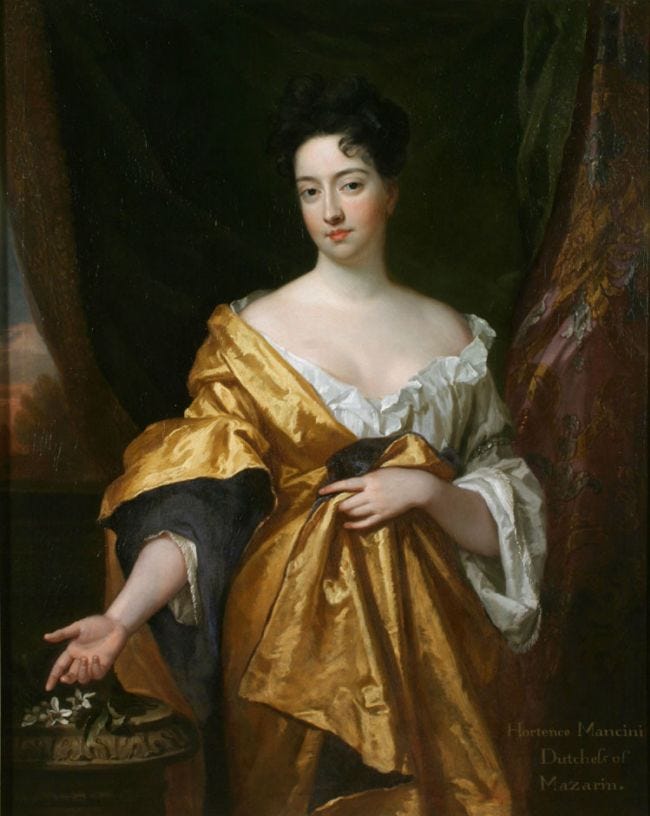
How did the wives of Charles and James cope with their adulteries?
Andrea: Charles’ adultery began quite differently from what many might assume. When, in 1660, he was restored to the throne, he was unmarried yet already engaging in adultery because his lover, Barbara Villiers, was another man’s wife! In my biography of her, ‘Ravenous: A Life of Barbara Villiers, Charles II’s Most Infamous Mistress’, I argue that Barbara was, from the beginning of Charles’ reign, his de-facto wife and queen, and when he married Catherine of Braganza in 1662, it was Catherine and not Barbara who was “the other woman”. Catherine fell in love with Charles, and certainly had a difficult time with her husband’s blatant and constant philandering, and the cruelty and humiliation of having to live in close proximity to not only his mistresses, but his many illegitimate children, when she was desperate to have her own. She would, however, following Charles II’s death, eventually return to her homeland, Portugal, where she successfully ruled as a powerful regent for her ill brother until her death in 1705. James II had two wives: the first lady, Anne, turned to food, socialising, and commissioning artwork from Peter Lely. James’s second wife, Mary of Modena, was the opposite when it came to food. John Evelyn observed how sad she looked following the investiture of James’s mistress, Catherine Sedley, and noted how little she ate. She turned, however, to her Roman Catholic faith, which was her rock throughout the turbulent years to come following the ‘Glorious Revolution’ in 1688/89 and her family’s subsequent years of exile in France.
Justine: Charles II’s queen, Catherine of Braganza, had a difficult time of it. She arrived from Portugal, the product of a very formal court, and was thrown into a much wilder scene. Charles’s affairs were flagrant. Catherine tried to resist his plan to instal his notorious mistress Barbara Palmer as one of her ladies-in-waiting, something Catherine found humiliating. But he would not be swayed. Unfortunately, Catherine was not able to produce children; she had little leverage. Meanwhile, the king’s mistresses kept presenting him with babies. He had about 14 royal bastards. But Catherine rallied—she knew how to enjoy herself with her friends, playing games and even going out in disguise. She also busied herself with rebuilding English Catholic institutions for young women. And although Charles was blatantly unfaithful to Queen Catherine, he rejected his ministers’ efforts to have him put her away just as Henry VIII had done to Katherine of Aragon. They tried to have Catherine of Braganza sent to the colonies, but Charles wouldn’t hear of it. In that respect he was loyal to his wife. He was fond of her and knew his duty to her.
As for James, he was guilty of treating his wives’ maids of honour as his personal harem. Anne Hyde liked to have a handsome court. She showed her household off by commissioning Sir Peter Lely to paint the famous ‘Windsor Beauties’ series, the ultimate images of the Restoration court, all satin, pearls and bedroom eyes. (I have an Instagram account, Justine Brown’s Bookshelf, devoted to 17th century portraits and the stories behind them.) Meanwhile, James was pursuing and bedding a great many of these young ladies. Anne Hyde became miserable and took solace in overeating. She grew very heavy, which didn’t help matters. Then, encouraged by a trouble-maker, Anne Hyde flirted a little in revenge. James fought back by giving her the silent treatment.
After poor Anne Hyde died of breast cancer in 1670, James sent an agent to the Continent to find him another Duchess of York. Charles was determined that this time his brother would marry for the family’s interest. James stipulated that his new bride be beautiful; he wanted a lady who could keep his interest. High-born and wealthy went without saying. His agent, Lord Peterborough, managed to secure the lovely young Mary of Modena, a member of the great Este family. Mary actually wanted to take the veil when Pope Clement X intervened, saying she was needed to serve the Catholics of the British Isles by marrying James Duke of York, she accepted. James was Charles’s heir since the king had no legitimate offspring.
After a rocky start, Mary of Modena fell deeply in love with her husband and he reciprocated. However, was still keeping Arabella Churchill in a house near St James’s Palace. In fact when Mary arrived in November 1673, Arabella had just given birth to one of four ‘FitzJames’ children. As the name means ‘son of James’, it announced their paternity. Mary of Modena was a passionate and tempestuous young lady, and any reminders of James’s sustained affairs with Arabella—and later Catherine Sedley—sent her into storms of tears. John Evelyn writes about it in his diary. Mary was often pregnant herself, but until 1688 all of her children died as infants. So when her husband’s royal mistresses gave him thriving boys and girls, it was painful indeed. Ironically, when Mary finally was able to give her husband a healthy son, Prince James Francis Edward, it basically put an end to his reign.
You can find Andrea online at andreazuvich.com and on Instagram at @17thcenturylady
Find Justine on Instagram at @justinebrownsbookshelf
The Stuart History Festival Tickets
In Person
You can see Andrea and Justine at the Stuart History Festival at the Old Palace, Worcester at 11am on Sunday 6th July.
Online
An Online Pass is also available which allows you to watch live, and play back for a limited time, for just £45. Find out more by clicking the button below.
Festival Schedule
Visit https://www.tickettailor.com/events/thestuarthistoryfestival for full details and to purchase all tickets, day passes and the online pass.
Books and Book Signings
Event Speakers’s books will be available to buy at the festival but if you can’t make it, or are watching online you can buy them online and have them shipped anywhere in the world, at Blackwells, click on the banner below.
My Interview with the Organisers
Find out why the 17th Century is such a great topic for a festival of its own - and why we think it hasn’t already got one, in my interview with the festival’s organisers; Dr Erica Canela, Andrea Zuvich and Mark Turnbull.
Next time…
The Quakers were not a plain or pure as we think! I’m joined by Dr Erica Canela and Dr Isabella Rosner to reveal more.
See you soon!
Philippa 💜



